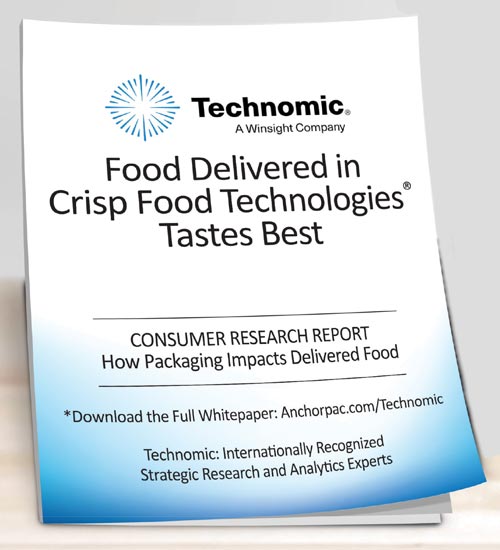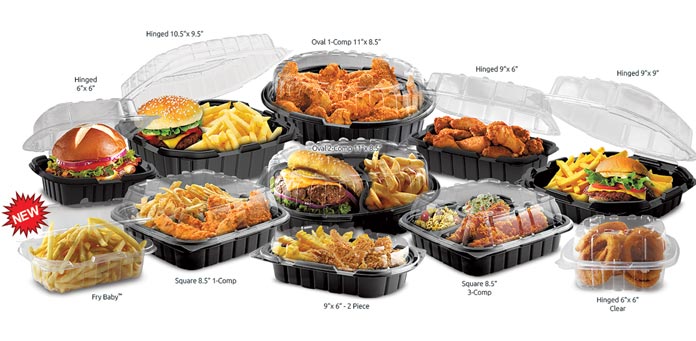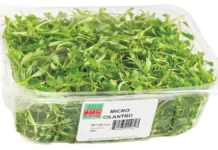 Among the pandemic’s most significant impact over the past six months has been a change in the importance of Takeout & Delivery for Metro New York and the nation’s restaurateurs.
Among the pandemic’s most significant impact over the past six months has been a change in the importance of Takeout & Delivery for Metro New York and the nation’s restaurateurs.
“What at one time was simply a supplement to many foodservice operators has evolved into a crucial revenue stream,” noted industry professor Steve Zagor who teaches at both Columbia University and the Institute of Culinary Education in New York City. Supporting the veteran educator’s comments is new research from Technomic.
Technomic sought to understand the impact of different packaging choices on the consumer-perceived quality of a delivered meal. Is there a packaging solution available to protect the temperature, texture, and taste of the meal? The answer is yes, Crisp Food Technologies® containers from Anchor Packaging. These containers protected fried food’s temperature and texture, after a simulated 30-minute delivery period, better than any other packages tested. Notably, consumer participants also reported the food delivered in these packages tasted best.
For 50 plus years, the restaurant and foodservice industry has looked to Technomic to help make sense of the marketplace changes. Technomic, Inc., was founded as a management consulting firm in 1966.
The new report notes that although takeout and home delivery of food has existed in some form for decades, the most significant growth has come in the last five years. It identifies millennials, and later Gen Z’s as the driving force behind this disruptive change in how consumers preferred to receive their food to maximize lifestyle convenience.
Even before the events associated with Covid-19, analysts and industry experts predicted exponential growth of takeout & delivery to $88 Billion by 2023. The report outlines how the pandemic brought legislative dictates, including associated shelter-in-place laws and restaurant indoor dining facilities’ mandated closures. These factors were the catalyst behind how home delivery and takeout quickly became the predominant means for American consumers to obtain prepared food.
Most importantly, the experts cited uniformly agree that the long-term impact of takeout & delivery growth is here to stay. Even when the virus is no longer a threat, off-premise dining will remain at elevated rates and increase further, as consumers have been exposed to a new level of convenience and their behavior irrevocably changed.
“Convenience can only drive that marketplace if the quality of the food enables the consumer to replicate their restaurant experience,” added Professor Zagor of Columbia and ICE.
Off-premise dining inherently comes with the significant challenge of delivering a restaurant-quality food experience after an average of 30 minutes of transit time. This challenge is incredibly daunting for fried foods, where taste satisfaction is almost entirely dependent on maintaining both texture and temperature. Technomic’s research outlined that non-fried foods adversely affected by excess moisture pose a similar obstacle to maintaining quality.
Many restaurants and foodservice operators were not prepared for the challenges that came with growth in an area where they had little or no expertise. As foodservice operators began to respond to the increase in online ordering and delivery, they initially approached the opportunity only as an increase in business-as-usual.
However, many quickly realized the difficulties presented by technology, including limited or non-existent ordering platforms. As they scrambled to find efficient hardware and software to support the increasing demand, operators also found that to-go packaging, which had previously approached with a “doggy bag” mentality, had significantly grown in importance.
“The right packaging speaks volumes to your customer about the commitment you have to doing it right,” Zagor added. Technomic’s report found that traditional food packaging may no longer be adequate when there is a significant time lapse between prep and consumption. This lapse is primarily due to food having to travel further to serve consumers off-premise. The average 30 minutes added for delivered meals can negatively impact food temperature and taste, presenting a challenge, and in many cases an obstacle, to meeting consumer expectations.
The report noted that consumers are looking for the same food experience they enjoy in the restaurant. That expectation has been bolstered by some forward-thinking restaurant operators who have successfully delivered on that goal, and the subsequent praise and visibility they have received on relevant consumer review sites.
 Fried foods are particularly challenging because the taste experience is dependent on maintaining both texture and temperature, both of which suffer as time elapses. The most ordered item for food-to-go is French fries, and it is not a coincidence that the top consumer complaint about off-premise dining is cold or soggy fries. However, chicken strips, nuggets, wings, egg rolls, fried vegetables, and hamburger buns are equally vulnerable to degradation by trapped humidity. Ironically, these foods are among the most popular, as well.
Fried foods are particularly challenging because the taste experience is dependent on maintaining both texture and temperature, both of which suffer as time elapses. The most ordered item for food-to-go is French fries, and it is not a coincidence that the top consumer complaint about off-premise dining is cold or soggy fries. However, chicken strips, nuggets, wings, egg rolls, fried vegetables, and hamburger buns are equally vulnerable to degradation by trapped humidity. Ironically, these foods are among the most popular, as well.
“One of the most common strategies, we have seen throughout the pandemic has been restaurants cutting the number of items they are offering on their takeout & delivery menus,” Zagor explained. Some operators restricted the off-premise menu to only the foods that travel well. However, many found that limited choices significantly impact the number of consumers reached and reduces the average order size. Operators should keep their menu as broad as possible and find packaging solutions for items new to takeout and delivery.
Technomic brought their world-renowned research methodology to measure consumer perception of identical hot food when packed in different containers: plastic and fiber. Consumer participants rated food appearance, texture, temperature, and taste. The research also probed if consumers are willing to accept lower quality when ordering delivery. It concluded that a consumer’s willingness to re-order takeout or delivery from an operator required high food quality.
The consumer interviews uncovered a series of insights regarding the impact of the packaging choice on food after 30 minutes. They were consistent across the consumer test group and within each packaging type.
Among the findings was the insight that retaining heat is good, but excess heat and humidity negatively impacts taste when it impacts texture. The research found that to protect taste, an operator needed packaging with a ventilation system capable of removing excess humidity while retaining heat and enough moisture to maintain flavor and texture.
Only one package retained heat without impacting texture and taste: Anchor Packaging’s Crisp Food Technologies® containers. The packaging with patented, crossflow ventilation removed excess humidity while retaining heat and the proper moisture to maintain the taste and crunchy mouthfeel.
“With takeout and delivery here to stay and so much more riding on its success, operators need to make a commitment to quality packaging,” Zagor concluded. His thoughts coincide with the three crucial findings of the study. First, operators can maintain the restaurant taste experience in off-premise dining by protecting both the food’s temperature and texture as it travels the “last miles” before being eaten. Secondly, packaging that can handle the average 30-minute transit time plays a pivotal role in the food taste experience. Finally, and most importantly, operators can develop a packaging plan to successfully leverage food-to-go growth as a permanent part of the business plan.























